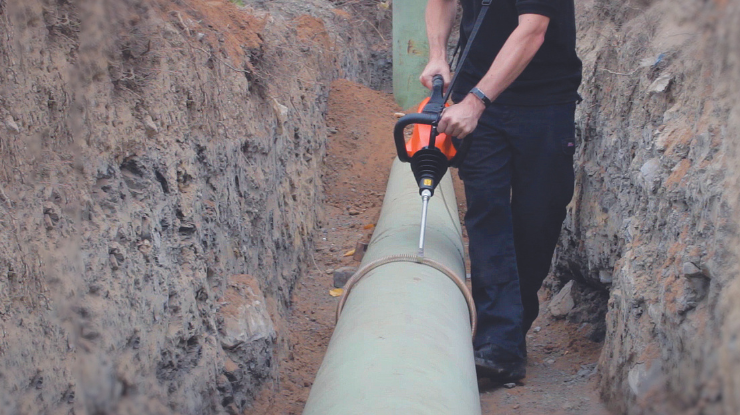PULSED DC: Premium Porosity Testing

The high voltage or porosity technique is ideal for inspecting pipelines and other protective coatings on either metal or on concrete substrates.There are three high voltage testing methods: AC, continuous DC and pulsed DC. In this issue, we will be exploring the pulsed DC method.
High voltage testing is where a high voltage is applied to a probe, which is then passed over the coated surface. The voltage used should be high enough so that in areas where the coating is electrically weaker due to a discontinuity, there is sufficient voltage to break down the gap or insulation between the probe and the substrate. When this breakdown occurs, the current flows from the probe, through the substrate, and back into the porosity meter (often referred to as a holiday detector) via an earth or signal return cable, thereby completing a circuit and triggering an alarm to signal that a flaw has been detected. The allowable number of 'holidays' or discontinuities should be determined prior to conducting this test since the acceptable quantity of discontinuities will vary depending on coating film thickness, design and service conditions. Pulsed DC is a time-dependent voltage signal with defined periods of when a specified voltage is applied, alternated with periods of no applied voltage. Effectively, the applied voltage is repeatedly turned on and off, many times per second.
Direct substrate to ground contact not required
Unlike continuous DC holiday detectors, the signal return cable of the pulsed DC method does not have to be connected directly to the conductive substrate. Pulsed DC Holiday Detectors, such as the Elcometer 280, can be used with a trailing lead making them ideal in many situations such as testing on large surface areas, on pipelines or inside tanks where attaching a cable is simply unrealistic.
Can be used on damp or dirty surfaces
Using pulsed DC technology, the Elcometer 280 Pulsed DC Holiday Detector is designed to ensure that the energy is contained within very short pulses, each pulse having more energy than an equivalent continuous DC system. This means that the detector can be used to test for holidays over slightly conductive coatings, or dirty or damp surfaces - since the technique is pulsed, telegraphing is often prevented.
Ideal for new or old coatings
As pipeline coatings are mainly applied in thick, continuous layers on new pipelines in the field, the use of a pulsed DC holiday detector to detect flaws in coatings applied to new pipeline constructions is preferred to the continuous DC system. It is also necessary to survey the condition of the coating during the service life of a pipeline and the pulsed DC method also offers some advantages for testing coatings that have been in service, whereas the continuous DC technique is mainly limited to newly applied coatings.
Safe and easy to use
Designed to make pulsed DC high voltage detection safer, easier, and more reliable, the Elcometer 280 is a “stick type” holiday detector that is capable of up to 30 hours of continuous use depending on the voltage and load applied. The quick-release battery pack can be fully charged in just four hours. The Elcometer 280 can also automatically work out your test voltage with its in-built voltage calculator - choose your test standard and enter the specified coating thickness and the gauge will automatically calculate, set and continuously ensure that the correct voltage is being applied using its built-in voltage "jeep" tester.
Wide range of probes
Elcometer has a wide range of probes for different applications and coating types including:
- Rolling Springs; available in stainless steel or phosphor bronze, are placed around the external diameter of the pipe and rolled along the surface.
- ‘C’ Brushes; swept along the outer surface of the pipe.
- Internal Pipe Brushes; swept along the inside of a pipe to check the internal surface for holidays. This accessory is limited by the reach of the operator along the internal bore however extension pieces overcome this.
- Right Angle Brushes; for larger flatter surfaces, can be tested with one of two styles - the right angle rubber probe and the right angle wire brush probe - both available in three widths from 250mm to 1000mm.
